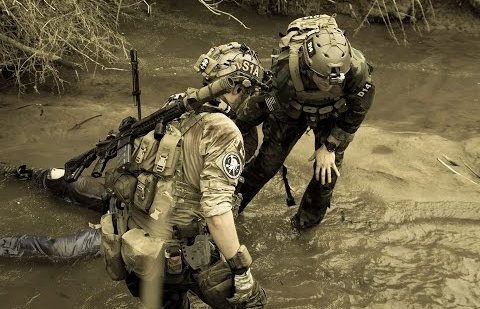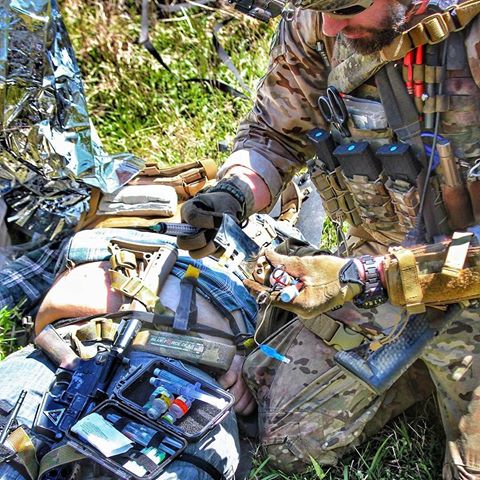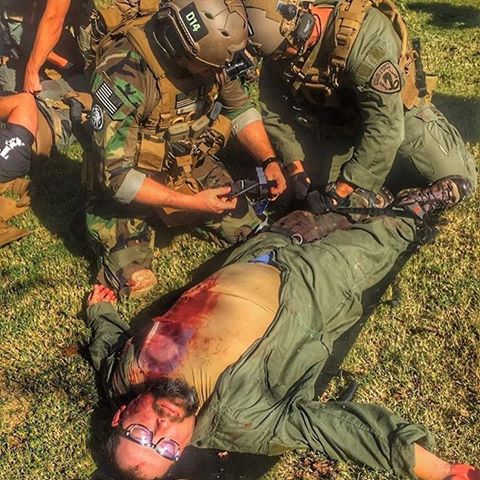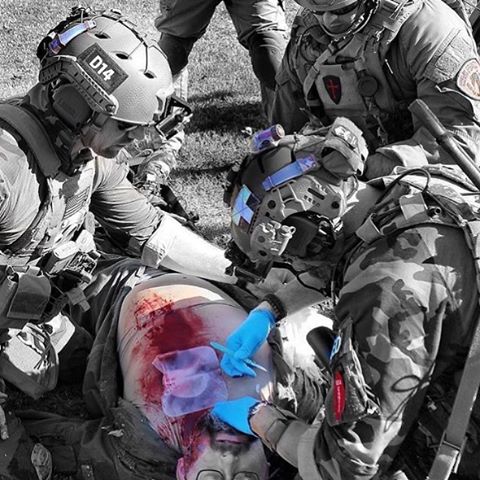The information we posted below comes from our friends at CAGMAIN and is a reposting of their original article. A good web search will turn up additional info and aspects of what they put forth as a basis for their argument. Please check out their website and learn from some well trained pros.~Editor
In the medical world, every lifesaving item you select to go into your aid bag is a critical piece of gear and should be viewed as a NO FAIL item, after all lives are actually at stake. When introducing a new medical product into the market, a professional should have the research and data readily available to back up their claims for said product. The basis of this article is about standards and maybe highlight some of the gimmicks that have been floated around to make a quick buck. Medical standards are critical with tourniquets (TQ) and their effectiveness because of the competitive history between military and civilian trauma models.
Always training
As a former Special Missions medic who served as a voting member of the Committee on Tactical Combat Casualty Care (CoTCCC), the subject of tourniquets is very near and dear to me. Standards are essential and this article will discuss what the standard isn’t and can’t be, what the standard looks like, how standards are achieved, followed by an example of what to look for when making tough decisions with your limited budget.
Full disclosure: We sell the Combat Application Tourniquet (CAT)
What the Standard Isn’t When shopping for gear, we often look to industry leaders as they have the credibility and experience to make recommendations for the inexperienced or new. But how is that credibility achieved? It’s the proven history of having done the hard work up front and having the documentation to show for it. If the only selection criteria someone has is how cool or “operator” a guy is there’s going to be mistakes, and the medical world is no different. Consumers make the obvious assumption that due diligence has been made by the professionals in question. This isn’t always the case, so its important to do some homework. Pulse oximetry is no where near the performance standard for a TQ. There are heart patients with no Pulse ox readings in some limbs….no tourniquets!
Marketing IS NOT data. “Cool guy Johnny” used “product XYZ” is NOT data. It validates their experience but offers no quantifiable performance metric. Just because an operator designs and uses it doesn’t mean it works, or will work for you. Where is the data collection, the peer-reviewed studies, and the study comparisons?
Simply put, “Tacticool” is not a standard.
Often times, operators are only using a particular device, because this research was ALREADY conducted… When introducing a new device, just saying a Green Beret, Ranger or Navy SEAL used it isn’t enough, nor should it be because the lives of our family friends and peers are on the line.
The fact is, a good medic can make bad gear work in a pinch. But that level of anecdotal evidence shouldn’t be confused with a product that will perform at the lowest common denominator.
Always training
What the Standard Looks Like Larry Vickers routinely presents, in an educational format, the quality of his content and ihe validates what he teaches and why his product concepts work. He provides quantifiable data and demonstrations that support his methodology. Although his tactical experience is relevant, Mr. Vickers has created a virtual encyclopedia of content and data for his approach to tactical shooting and product development. He puts in the work and validates it without relying on “Tacticool” for credibility. He is “Tacticool” because he IS credible.
For a tourniquet, the accepted standard for performance is a Doppler study and in some cases, the ultrasound. It’s the only way we can ensure that the device has achieved total arterial occlusion, also known as stopping the blood flow. This test needs to be performed on a human thigh, due to the large amounts of tissue and pressure required to achieve end state. Basically, we need to see if a tourniquet on the upper thigh is strong enough to cut off blood flow all the way down in the foot.
Arms are, generally speaking, easy to do and shouldn’t be the comparative standard for use in the field. A tourniquet must work on both the legs and arms if it’s going to make it into an aid bag. There are a few other variables we also need to consider such as TQ width, ease of application and design but none of those mean anything if at the end of the day the TQ doesn’t stop a major femoral bleed.
There is no question that a skilled provider can create an improvised TQ that meets all of these criteria and will perform when the moment of truth has arrived, but the conventional homemade TQ doesn’t offer the market a PREDICTABLE standard in which to train, compare, plan and gather data. Manufactured TQs provide standardization and the ability to teach down to the lowest common denominator so that critical life savings skills can be decentralized into the hands of untrained providers.
Dr. Zeitlow reviewed the prehospital use of tourniquets (CAT Tourniquets used on 73 patients with 98% success) and Combat Gauze (used on 52 patients with a 95% success rate) in the Trauma Service at the Mayo Clinic. He added that “improvised tourniquets were uniformly unsuccessful.” Dr. Zeitlow also noted that the Mayo protocol calls for Combat Gauze to be used only after failure of standard gauze. There are 2 CAT tourniquets and 2 Combat Gauzes on each prehospital vehicle or aircraft. -CoTCCC minutes 2014-
When building up to human studies you often see a lot of testing done with non-human models, for example live tissue and even mannequin or cadaver tests. Again, still not the gold standard even though it seems they are validating the product. This is important to understand because there has been a release of various test data comparing the Rapid Application Tourniquet System (RATs) TQ against the CAT TQ on a mannequin.
While the findings are indeed in favor of the RATs, this data in no way undermines the value and performance of the CAT nor does it provide gold standard test results for the performance of the RATs.
The CoTCCCs Role in Today’s Accepted Standards It needs to be said that few groups of people have done more to save the lives of American Service members than the CoTCCC. They have a well-documented, battle proven track record of medical excellence. The CoTCCC are directly responsible for the current level of professional respect the military and special operations currently enjoys in the medical community nationwide, better yet, GLOBALLY. In the last few days I’ve read a lot of attacks on the CoTCCC in favor of fads, and it reflects poorly on the veteran community as a whole.
Most active duty service members aren’t aware of the CoTCCC because they have only been exposed to the intellectual product that they have been provided, loosely called TCCC. For active duty service members TCCC and CoTCCC are indistinguishable because it’s only in the civilian market where there is a new difference in the meaning.
I’m not going to get into who did what and for what trademark, just know that if you have to play “six degrees of separation” to substantiate your TCCC claim, it’s misleading. My personal synopsis of the labeling issue is that the product was marketed and released before it was fully tested. In most cases that’s ok because sales feedback is critical, but not in the medical world. A medical device will be in court and on trial the first time it fails. This has a huge potential to damage the credibility of the military medical model. It’s not a popularity contest, it is life and death so standards must be achieved and then maintained.
The RATs TQ displays the big red label associated with TCCC. This is misleading but I don’t entirely put the blame on the RATs team, rather the company that markets the label. I know what it takes to get a medical device up and running and, thanks to regulation, it’s nearly impossible. The temptation to cut corners is too great to put the blame entirely on the makers of the RATs. Competing in a market dominated by the FDA is a challenge to all medicine and not just veteran owned companies.
Whether it works or not is irrelevant to the fact that professional credibility has been entirely undermined by this marketing tactic. Moving forward, how are we to accept the validity of any research done in support of the RATs? A veteran owned business is not removed from the challenges of competing in a free market, and that means creating content and products that withstand scrutiny and criticism, beyond the standards of a civilian company. The established civilian market doesn’t want to compete with us, they want us to falter. We have the experience to back up our ideas so veterans don’t have to dabble in conjecture.
Weaponized Medicine @savage_focker and @angry.canadian
There is an entire community of civilians looking to undercut the military medical model, especially in trauma, and its gimmicks like this that will feed their machine. Credibility is king. I want to be clear, I’m not shooting down the efficacy of the RATs TQ, but I see nothing that demonstrates proven performance. At first glance it appears to be a glorified rehash of the old surgical tubing and it looks like a lot of other designs that have come and gone in the last few years. I’d like to see the testing, I’d like to see results. If it turns out to be the next big thing then great, good for them. At the end of the day I wish them luck, but it looks like the cart is ahead of the horse.
What Should You Be Looking For? That depends on what kind of market you’re in. The war has been going on for 15 + years, so it’s not that there isn’t room for innovation but there isn’t any need to take chances either. The data is out there to substantiate the extra dollars on a limited personal budget. The question is how bad do you want to save $15? As I’ve mentioned from the onset of this article, we sell the CAT tourniquet and for good reason. I have personally used them so I’m happy to endorse them, but the CAT has a long-standing, well documented history of saving lives. As recently as last year, the Mayo Clinic is reporting upwards of a 98% success rate for properly applied CAT TQs in a pre hospital setting. I’ll accept that standard for my family.
It is one of the industry dominating products because the data is out there to validate the few extra dollars it costs to buy one. Take a look and see, then ask yourself, does your tourniquet have any real results behind it? The CAT does and we’ve provided it below.
Conclusion Medicine is an established industry with proven practices and standards that have been set for years because they have the proof that this approach works. Few markets have the same level of scrutiny as the medical and medical malpractice industry. Even Special Operations follows and acknowledges this fact, and it’s this approach to research and development that has established the SOF community as a credible research and development institution. We have to be careful as a community not to overlook quality standards in favor of the cool factor.
Our company, Crisis Application Group Inc. (CAG) won’t be testing the RATS TQ. At the end of the day it’s the responsibility of the manufacturer to prove the validity of their product, not the job of competitors to disprove it. Our initial impression of the RATs TQ is so what, show me the data. We won’t be going down the “rabbit hole” of will it work or why it works, or doesn’t. That’s not to say it won’t, it’s just that we aren’t buying into the “Tacticool” marketing. Maybe one day the RATs will be ready for the big leagues, but so far it’s not and there’s a lot of work ahead of them. CAG will stick to proven methodology, technology, and personal experiences.
Open source data: Combat Application Tourniquet cotccc-meeting-minutes-1402-final 030. CAT_Single-Routing_ 024. Final_tourniquet_working_group_minutes_march_2010 Chpt 8-Pg 91 023.1 TK CALL AAR_Jul-09 rebuttal to Johnson 026. The Military Emergency Tourniquet Program’s lessons Learned with Devices and Designs – 2011 027. Tourniquets – 2011 029. Re-Evaluating the Field Tourniquet for the Canadian Forces 032. Israeli NSW Feedback_to _the_Field_(FT2F) #11 FT2F #12 – TQ Use in OEF OIF and OND – 16Jul12 022. Battle Casualty Survival with Emergency Tourniquet Use to Stop Bleeding – 2009 General TQ studies (Good reading) 009. Surgical Tourniquet Technology Adapted for Military and Prehospital Use – 2004 010. Labortory Evaluation of Battlefield Tourniquets in Human Volunteers – 2005
*The views and opinions expressed on this website are solely those of the original authors and contributors. These views and opinions do not necessarily represent those of Spotter Up Magazine, the administrative staff, and/or any/all contributors to this site.




